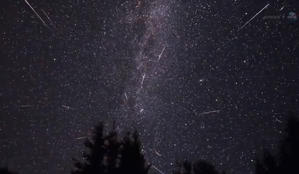Lyrid meteor shower lights up the night sky this week
Posted on April 17, 2013 by The Extinction Protocol
 April 17, 2013 – SPACE - The
April 17, 2013 – SPACE - The
Lyrid meteor shower begins today, as the Earth makes its annual pass
through the trail of dust left behind by Comet Thatcher, which last
swung through the inner solar system in 1861. The meteor shower lasts
for an average of about 10 days, starting on or about April 16th,
peaking around the 22nd, and then ending sometime around April 25th or
26th. At its peak, stargazers typically spy around 20 meteors per hour,
although that can vary from year to year, as there are parts of the dust
trail that are thinner or thicker. Apparently, in 1982, the Earth
passed through a particularly dusty part of the trail and observers were
treated to a meteor storm, seeing upwards of 90 meteors per hour. In
2012, the meteor shower sported two peaks, one on April 22nd, when
people reported seeing around 25 meteors per hour, and then,
unexpectedly, it experienced a second peak just before the shower ended
on the 26th, when observers spotted between 15 and 68 meteors per hour
(depend on where they were). Also, during this particular meteor shower,
a particularly large object entered the atmosphere, producing an
exceptionally bright fireball and a loud sonic boom over California and
Nevada on the morning of April 22nd. Pieces of this ‘bolide’ were
recovered near Sutter’s Mill, the location that started the California
Gold Rush in 1848. The 2012 Sutter’s Mill meteorite, as it came to be
called, was estimated at being between 2 and 4 metres in diameter, and
it exploded with a force of about a 4 kiloton nuclear bomb. –Yahoo
Thanks to: http://theextinctionprotocol.wordpress.com
Posted on April 17, 2013 by The Extinction Protocol
 April 17, 2013 – SPACE - The
April 17, 2013 – SPACE - TheLyrid meteor shower begins today, as the Earth makes its annual pass
through the trail of dust left behind by Comet Thatcher, which last
swung through the inner solar system in 1861. The meteor shower lasts
for an average of about 10 days, starting on or about April 16th,
peaking around the 22nd, and then ending sometime around April 25th or
26th. At its peak, stargazers typically spy around 20 meteors per hour,
although that can vary from year to year, as there are parts of the dust
trail that are thinner or thicker. Apparently, in 1982, the Earth
passed through a particularly dusty part of the trail and observers were
treated to a meteor storm, seeing upwards of 90 meteors per hour. In
2012, the meteor shower sported two peaks, one on April 22nd, when
people reported seeing around 25 meteors per hour, and then,
unexpectedly, it experienced a second peak just before the shower ended
on the 26th, when observers spotted between 15 and 68 meteors per hour
(depend on where they were). Also, during this particular meteor shower,
a particularly large object entered the atmosphere, producing an
exceptionally bright fireball and a loud sonic boom over California and
Nevada on the morning of April 22nd. Pieces of this ‘bolide’ were
recovered near Sutter’s Mill, the location that started the California
Gold Rush in 1848. The 2012 Sutter’s Mill meteorite, as it came to be
called, was estimated at being between 2 and 4 metres in diameter, and
it exploded with a force of about a 4 kiloton nuclear bomb. –Yahoo
Thanks to: http://theextinctionprotocol.wordpress.com






 Sat Mar 23, 2024 11:33 pm by globalturbo
Sat Mar 23, 2024 11:33 pm by globalturbo

